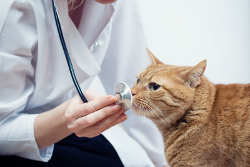Feline stomatitis is a very painful condition. It is an umbrella term that is used for the swelling and inflammation of the mouth. The pain is so significant that as the condition progresses, the cat will stop eating. Also in cases of Stomatitis in Cats, the area around the hinges of the cat’s jaw and the back of the mouth is visibly red and inflamed. The gums and gumline may also appear red, meaty, and swollen.
Causes of Stomatitis in Cats
Stomatitis in cats can be attributed to various causes and is most likely due to a number of factors. The exact details of how this condition is developed have not yet been fully understood. Many studies conclude that it stems from an overreaction of the body’s immune system to plaque buildup. The three most common factors seem to be:
Hyperresponsiveness:
- It’s thought that some cats are what is called ‘plaque-intolerant’. They tend to have an allergic reaction or a hypersensitivity to bacterial plaque. This reaction results in a disease called lymphocytic-plasmacytic gingivitis stomatitis (LPGS). It affects the whole mouth. Certain cells called lymphocytes and plasma cells that play a role in the immune system, travel into the soft tissue of the mouth and cause severe inflammation; thus, stomatitis.
- It is also possible that the cat is suffering from an allergic reaction to something else in his environment. An allergy to food or fleas can also present as oral and/or skin lesions, irritation and inflammation. These are called feline eosinophilic granuloma.
Immunosuppression:
- If a cat’s immune system is suppressed, such as by a viral and/or bacterial infection, stomatitis may occur. Fifteen percent of cats suffering from chronic oral inflammation are infected with feline leukemia virus (FeLV), or feline immunodeficiency virus (FIV), or sometimes both.
Its important to note that stomatitis in cats can be a life threatening condition. Affected cats will stop eating because it simply becomes too painful. They will begin to lose weight rapidly and are at risk for chronic malnutrition, dehydration, fatty liver, and hepatic lipidosis. Stomatitis occurs in all breeds of cats. However, it is most commonly seen in Persians, Himalayans, and Somalis.
Signs and Symptoms of Stomatitis in Cats
There are several common signs to indicate that your cat may be suffering from stomatitis. Some of these include:
- Red, inflamed, and/or bleeding gums
- Halitosis (extremely bad breath)
- Loss of appetite or anorexia
- Weight loss
- Excessive drooling
- A visible lack of grooming
- Pawing at the mouth
Some cats may also shy away from touch completely, or yelp when the mouth is inadvertently touched. Other cats may become more vocal for no apparent reason. Stomatitis in cats, should be taken very seriously so observe your cats behavior very carefully.
Treatment Options for Stomatitis in Cats
Various treatments exist for stomatitis in cats but there is only one that is considered as a potential cure:
A full mouth dental extraction
It may seem drastic but plaque is known to be a trigger, if there are no teeth for plaque build on, there will be no recurrence of stomatitis. In ninety percent of cases, this option cures the disease. The mouth should be x-rayed following an extraction to ensure that no roots are left below the gumline.
This option is costly but cat owners who have been suffering along with their cats through stomatitis for many years are happy they decided to go with this option. Despite what many may think, cats can eat just fine with no teeth. In fact, they will go on to eat better after their recovery due to the absence of the pain they were experiencing.
Like any treatment or procedure, it is not a guaranteed cure and in some cases, the cat may continue to have stomatitis. It’s important to discuss all options and weigh the pros and cons with your veterinarian. Do not be hesitant to voice any concerns or ask any questions.
There are other treatment options for Stomatitis in Cats, you can consider. We discuss some of these options below:
Steroids
Although they effectively suppress the immune system and ease inflammation in the mouth, they are considered a short-term solution. Stomatitis will reoccur and after long periods of steroid use, the cat will develop a resistance. Steroids are a serious drug with serious side effects including diabetes associated with long-term use.
Immunosuppressants
Cyclosporine has been shown to be effective in some cases, but not all. It is a costly drug with undesired side effects such as anorexia and sometimes, bone marrow suppression.
Antibiotics
- Azithromycin is commonly used to treat secondary infections that have been linked to stomatitis.
- Doxycycline offers an anti-inflammatory effect. It also helps by clearing up most secondary infections in the mouth.
Pain medication
Flare-ups will commonly be treated with either a narcotic or a medication called Buprenex. If the cat is not undergoing steroid therapy, Metacam is a pain medication that may also be prescribed.
Keeping the Infected Area Clean
Stomatitis in cats causes a build up of bacteria that will cause the condition to get worse if left untreated.
Proden plaqueoff is one way to fight the disease buildup in the mouth. It comes in a powdered form and you simply add it to your cats meals once a day.
It works by using a natural seaweed based formula to attack the bacterial biofilm that forms on the teeth and gums, treating plaque and tartar, bad breathe and gingivitis.
It is human grade and human tested. You can expect to see results over a 2-8 week period if the condition is not severe.
Tips for the Prevention of Stomatitis in Cats
- Start when a kitten is very young. Touch the face and the mouth. Accustom the kitten to having his mouth examined. Pull back the lips and gently touch the gums. This way, it will be easier to keep an eye on your cat’s dental health as he ages.
- As a cat owner, you can inspect the inside of your cat’s mouth every few months and simply perform a wellness check.
- There are kitty toothpastes, and water additives on the market at pet specialty stores everywhere.
- Have your cat undergo a professional teeth cleaning once a year. This is a very common procedure that consists of your cat going under anesthesia while the attending veterinarian thoroughly scrapes the plaque away.
- If you notice any foul breath, or redness along the gumline, advise your veterinarian immediately.
Thanks for visiting www.catdandruffclinic.com, if you liked this article please like us using the side bar .
Related Posts:



Comments are closed.